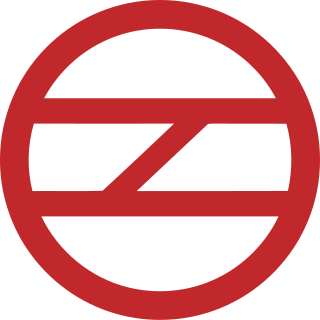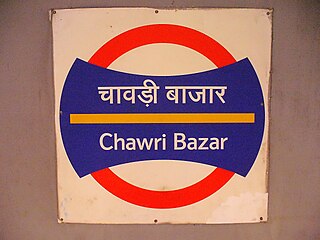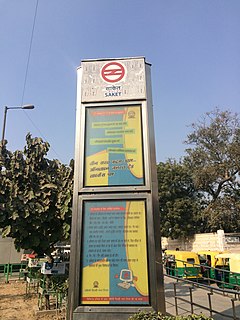
Saket is a residential colony and the administrative headquarters of the South Delhi district of Delhi in India. The neighborhood is named after the city of Ayodhya, also known as Saket, an ancient, religiously significant city in Uttar Pradesh. Saket has four major malls on the Press Enclave Marg.

The Yellow Line is a metro rail line of the Delhi Metro, a rapid transit system in Delhi, India. It consists of 37 metro stations from Samaypur Badli in Delhi to HUDA City Centre in the neighbouring city of Gurugram in Haryana. The line with a length of 48.8 kilometers (30.3 mi) is mostly underground and has been laid under one of the most congested parts of Delhi. The 4 kilometers (2.5 mi) stretch from Vishwa Vidyalaya – Kashmere Gate, constructed by Kumagai-Skanska-HCC-Itochu Joint Venture (KSHI-JV) is the first section of the underground Delhi Metro line which was opened to public on 20 December 2004. KSHI-JV is a joint venture between Kumagai Gumi, Skanska, Hindustan Construction Company & Itochu.

The Chennai Metro is a rapid transit system serving the city of Chennai, Tamil Nadu, India. It is the third longest metro system in India after Delhi Metro and Hyderabad metro. The system commenced service in 2015 after partially opening the first phase of the project. The network consists of two colour-coded lines covering a length of 54.15 kilometres (33.65 mi). The Chennai Metro Rail Limited (CMRL), a joint venture between Government of India and the Government of Tamil Nadu built and operates the Chennai Metro. The system has a mix of underground and elevated stations and uses standard gauge. The services operate daily between 4:30 and 23:00 with a varying frequency of 5 to 14 minutes.

Chandni Chowk is a station on the Yellow Line of the Delhi Metro. It serves the Chandni Chowk market area, and is near the Red Fort. It is also walking distance to the Old Delhi Railway Station of Indian Railways.

Delhi Metro Rail Corporation Limited (DMRC) is a centre-state public sector company that operates the Delhi Metro. The DMRC is also involved in the planning and implementation of metro rail, monorail, and high-speed rail projects in India and abroad. The work of DMRC is broadly fragmented into various parts namely Projects, Operation and Maintenance, Finance, Human Resources etc. which are controlled by the respective directors under the direction of managing director.

Malviya Nagar is a locality in South Delhi. It is between Saket and Hauz Khas and close to IIT Delhi. It is named after the freedom fighter Madan Mohan Malviya who was also an educator and founded Banaras Hindu University.

The Orange Line or Delhi Airport Express Line is a Delhi Metro line from New Delhi Metro Station to Dwarka Sector 21, linking Indira Gandhi International Airport. The line was opened on 23 February 2011 after missing four previously set deadlines. It was built at a cost of ₹ 57 billion, of which Reliance Infra paid ₹ 28.85 billion (U$580m), Reliance Infra will also pay fees on a Revenue-share model

Chawri Bazar is an underground station located on the Yellow Line of the Delhi Metro, a rapid transit system serving Delhi and its satellite cities in the National Capital Region of India. It is located in the Chawri Bazaar locality of Old Delhi and was inaugurated on 3 July 2005 as part of the Kashmere Gate – Central Secretariat corridor.

The Malviya Nagar Metro Station is located on the Yellow Line of the Delhi Metro.

The Saket Metro Station is located on the Yellow Line of the Delhi Metro. It is the last underground station on the southern end of the Yellow Line of Delhi Metro.

The Delhi Metro is a mass rapid transit (MRT) system serving Delhi and its satellite cities of Ghaziabad, Faridabad, Gurugram, Noida, Bahadurgarh and Ballabhgarh, in the National Capital Region of India. It is by far the largest and busiest metro rail system in India, and the second oldest after the Kolkata Metro. The network consists of 10 colour-coded lines serving 253 stations in Delhi with a total length of 348 kilometres (216 mi) and has a full reach of 285 stations with a total length of 389 kilometres (242 mi) when including the Gurugram Metro and Noida Metro. The system has a mix of underground, at-grade, and elevated stations using both broad-gauge and standard-gauge. Delhi Metro operates over 2,700 trips daily, starting at around 05:00 and ending at 23:30.

Kolkata Metro Line 2 is a rapid transit line of the Kolkata Metro in the Indian state of West Bengal. It currently consists of an operational section between Salt Lake and Phoolbagan, and will eventually connect Teghoria with Howrah by going underneath the Hooghly River. It would consist of 17 stations from Teghoria (Haldiram) in the east to Howrah Maidan in the west, of which 11 would be elevated and 6 would be underground, with a total distance of 22 km. It is expected to derive a very high ridership since it will connect India's two largest commuter railway and long-distance railway terminals along with two of its largest business districts. Line 2 has India's first underwater metro tunnel along with the deepest metro shaft. The first phase between Salt Lake City Sector V and Salt Lake Stadium was inaugurated by Union Railway Minister Piyush Goyal on 13 February 2020 and commercial services started from 14 February 2020.

The Doha Metro is a rapid transit system in Doha, Qatar's capital city, which became operational on 8 May 2019. It has three lines with an approximate overall length of 76 km and 37 stations. It is an integral component of the larger Qatar Rail network, which will include a long-distance rail for passengers and freight, linking Qatar to the GCC, and the Lusail LRT. Capable of reaching 100 km/h, the Doha Metro will be one of the fastest driverless trains in the world.

The Aqua Line 3 of the Mumbai Metro, also known as Colaba-Bandra-Seepz Line, is a part of the metro system under construction in Mumbai, India. When completed, the 33.5-km long line will be the first underground metro line in Mumbai and will be operated by MMRC. The metro line will connect Cuffe Parade business district in the extreme south of the city to SEEPZ in the north-central with 26 underground and one at-grade station. The track width is standard gauge. The cost of this corridor is estimated at ₹30,000 crore (US$4.2 billion). Line 3 is expected to reduce road congestion, besides reducing the load on the Western Line between Bandra and Churchgate.

The Magenta Line is a metro rail line of the Delhi Metro, a rapid transit system in Delhi, India and the first driverless metro in India. It consists of 25 metro stations from Janakpuri West to Botanical Garden, out of which 10 are elevated and rest 15 are underground. The total length of the line is 38.235 km out of which 14.428 km is elevated and 23.807 km is underground. Unlike the Airport Metro Express, this line will directly serve Terminal 1 of the Indira Gandhi International Airport.

Jama Masjid is a station on the Delhi Metro system. The Heritage Line stretch of the Delhi Metro was flagged off by Union Minister M. Venkaiah Naidu and Delhi Chief Minister Arvind Kejriwal on 28-May-2017. The corridor will be operational from 28-May-2017, the Delhi Metro Rail Corporation (DMRC) announced on 26-May-2017.

The Palam metro station is a part of the Magenta Line, connecting Botanical Garden in Noida to Janakpuri in west Delhi. It was opened to public on 29 May 2018.

East West Metro Tunnel is an under-construction underwater river tunnel of Kolkata Metro in Kolkata, West Bengal. The river tunnel is constructed underneath Hooghly River. Tunnel length is 10.8 km (6.7 mi) and width is 5.5 metres (18 ft). A 520m stretch of the tracks will go through a tunnel under the Hooghly River. The roof of the tunnel would be about 30 metres from the ground level. The tunnel will be completed in 2021. The tunnel will be the first underwater river tunnel in India. The tunnel is used by East West Metro Line for metro rail service and constructed by Kolkata Metro Rail Corporation.
Gülermak Ağır Sanayi İnşaat ve Taahhüt A.Ş. is a Turkish construction company, especially for rail transport, established in 1958. Since its establishment, has been a top leading international EPC contractor known for its excellent reputation and professionalism. Gülermak has been in operation since its establishment in the year 1958, and has been executing global turnkey civil infrastructure, and industrial construction projects. According to Engineering News-Record (ENR), in 2020 the company was the 124th international contractor in the world with revenues of $699.1 million. The company has offices in Ankara (Turkey), Warsaw (Poland), Stockholm (Sweden), Dubai, and Mumbai (India).













